
The 46 Knox-class frigates were the largest, last, and most numerous of the US Navy's second-generation anti-submarine warfare (ASW) escorts. Originally laid down as ocean escorts, they were all redesignated as frigates on 30 June 1975, in the 1975 ship reclassification plan and their hull designation changed from 'DE' to 'FF'. The Knox class was the Navy's last destroyer-type design with a steam turbine powerplant.
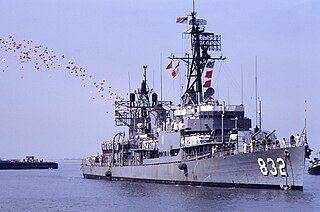
The Gearing class was a series of 98 destroyers built for the U.S. Navy during and shortly after World War II. The Gearing design was a minor modification of the Allen M. Sumner class, whereby the hull was lengthened by 14 ft (4.3 m) at amidships, which resulted in more fuel storage space and increased the operating range.

HMCS Yukon was a Mackenzie-class destroyer that served in the Royal Canadian Navy (RCN) and later the Canadian Forces. She was the first Canadian naval unit to carry the name. She was named for the Yukon River that runs from British Columbia through Yukon and into Alaska in the United States.

The C class was a class of 32 destroyers of the Royal Navy that were launched from 1943 to 1945. The class was built in four flotillas of 8 vessels, the "Ca", "Ch", "Co" and "Cr" groups or sub-classes, ordered as the 11th, 12th, 13th and 14th Emergency Flotillas respectively. The sub-class names are derived from the initial 2 letters of the member ships' names, although the "Ca" class were originally ordered with a heterogeneous mix of traditional destroyer names. A fifth flotilla, the "Ce" or 15th Emergency Flotilla, was planned but were cancelled in favour of the Weapon-class destroyers after only the first two ships had been ordered. The pennant numbers were all altered from "R" superior to "D" superior at the close of World War II; this involved some renumbering to avoid duplications.

The Claud Jones-class destroyer escorts were four destroyer escorts built for the United States Navy in the late 1950s. These ships were a diesel-powered version of the earlier Dealey class and were designed with the aim of producing a cheaper ship suitable for rapid production in wartime. These ships also had reduced armament and speed compared to their predecessors. They were not seen as effective anti-submarine warfare vessels by the United States Navy and were sold after only 15 years service to the Indonesian Navy.

HMCS Mackenzie was a Mackenzie-class destroyer that served in the Royal Canadian Navy (RCN) and later the Canadian Forces. She was the lead ship of her class and is the first Canadian naval unit to carry this name. The ship was named for the Mackenzie River, the largest river system in Canada and runs primarily through the Northwest Territories.

USS Stein (DE-1065) was a Knox-class destroyer escort, later redesignated as a frigate (FF-1065) of the United States Navy. She was named after Tony Stein, the first Marine to receive the Medal of Honor for action in the Battle of Iwo Jima.
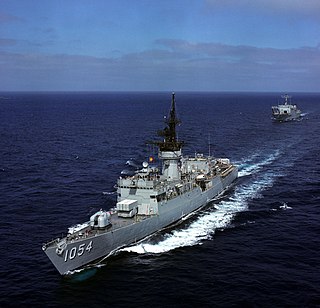
USS Gray (FF-1054) was a United States Navy Knox-class frigate. She was named for Marine Corps Sergeant Ross F. Gray, who was a posthumous recipient of the Medal of Honor.
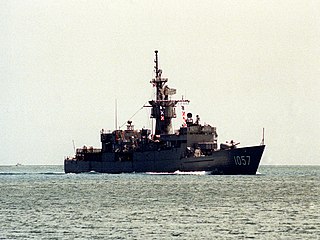
USS Rathburne (FF-1057) was a Knox-class frigate of the US Navy. Despite the different spelling, she was named for Continental Navy officer John Rathbun (1746-1782).

HMS Lowestoft was a Rothesay-class or Type 12 class anti-submarine frigate of the British Royal Navy. Lowestoft was reconstructed in the late 1960s to largely the same pattern as the third group of Leander-class frigates, with new radar and fire control and a hangar and pad for a Westland Wasp helicopter for longer range, anti-submarine, engagement. In the late 1970s it was converted as the prototype towed array frigate for the Royal Navy, but retained its full armament. Lowestoft was sunk as a target on 8 June 1986 by HMS Conqueror using a Tigerfish torpedo. She was the last Royal Naval target to be sunk still displaying her pennant number.
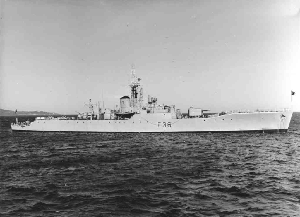
HMS Whitby was a Whitby-class or Type 12 anti-submarine frigate of the Royal Navy of the United Kingdom built by Cammell Laird and Co Ltd, Birkenhead. She was launched on 2 July 1954 and commissioned on 10 July 1956.

HMS Undaunted was a U-class destroyer of the British Royal Navy that saw service during World War II. She was later converted into a Type 15 fast anti-submarine frigate, with the new pennant number F53.

HMS Termagant was a T-class destroyer of the Royal Navy that saw service during the Second World War. She was built by William Denny and Brothers, of Dumbarton and launched on 22 March 1943. She was scrapped in 1965.

HMCS Qu'Appelle was a Mackenzie-class destroyer that served in the Royal Canadian Navy and later the Canadian Forces. The ship's insignia and logo was the head of a fox facing forward centered in a diagonal line double white with a red center sqiggley line from the top left to bottom right. The moniker of the ship was "Follow the Fox".

The Mackenzie-class destroyer was a class of warship used by the Royal Canadian Navy and Canadian Forces from the 1960s–1990s. Six such ships were envisioned, of which four were completed to this specification. The last two hulls were completed to the post DDH conversion St. Laurent-class design ; they were designated as the Annapolis class instead. The four Mackenzie-class destroyers spent most of their service in the Pacific Ocean, used primarily in a training role. Their only significant update was the DELEX program, which was completed between 1982 and 1985 and updated their navigational radar and their sonar.

HMCS Saskatchewan was a Mackenzie-class destroyer that served in the Royal Canadian Navy (RCN) and later the Canadian Forces. She was the second Canadian naval unit to bear the name HMCS Saskatchewan. The ship was named for the Saskatchewan River which runs from Saskatchewan to Manitoba in Canada.

The Annapolis-class destroyer escort was a two-ship class of destroyer escorts that saw service with the Royal Canadian Navy and Canadian Forces from the 1960s to the 1990s. The final version of the St. Laurent-class design, the class was used extensively for anti-submarine warfare purposes. Both ships were sunk as artificial reefs after being retired, one on each coast of Canada.
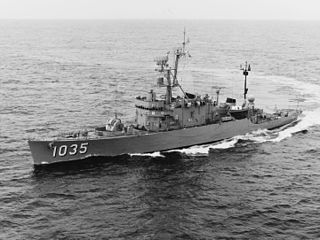
USS Charles Berry (DE-1035) was a Claud Jones-class destroyer escort named for Medal of Honor recipient Charles J. Berry. She was commissioned in 1959. The ship was sold to Indonesia in 1974 and renamed KRI Martadinata in honor of Vice Admiral Raden Eddy Martadinata, a former Indonesian naval commander.

HNoMS Oslo was an Oslo-class frigate of the Royal Norwegian Navy. The frigate was launched on 17 January 1964, and commissioned on 29 January 1968. Oslo ran aground near Marstein Island on 24 January 1994. One officer was killed in the incident. The next day, on 25 January, she was taken under tow. However as the situation deteriorated, the tow was let go and the frigate sank.

The Admiral Pereira da Silva class of frigates, also known as Admiral-class frigates, were in the service of the Portuguese Navy between 1966 and 1985. The class was based on the Dealey-class destroyer escort of the United States Navy. The three ships of the class were built in Portugal, at the Lisnave shipyards and the shipyards of Viana do Castelo. The construction of the ships was part of the effort of Portugal to expand its fleet in the face of unrest in the empire and was financed by the United States via the Mutual Defense Assistance Program. Financial problems prevented them from ever being modernised and they were deleted in 1989.



















